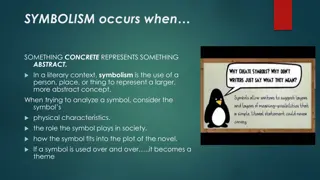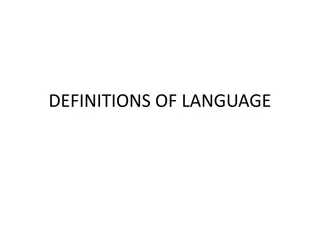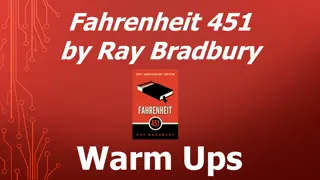Themes and Symbols in Fahrenheit 451
In "Fahrenheit 451," key themes and symbols like censorship, fire, knowledge vs. ignorance, and the hearth and the salamander are explored through characters like Montag, Mildred, Clarisse, and Beatty. Beatty's ambivalent tone towards the history of firemen reveals societal norms where conformity is enforced, individuality is suppressed, and intellect is shunned. The clash between knowledge and ignorance is symbolized by the destructive power of fire, used for censorship to maintain societal stability. Montag's personal growth and defiance against a controlling regime are highlighted as he embarks on a journey of self-discovery through forbidden books.
Download Presentation

Please find below an Image/Link to download the presentation.
The content on the website is provided AS IS for your information and personal use only. It may not be sold, licensed, or shared on other websites without obtaining consent from the author.If you encounter any issues during the download, it is possible that the publisher has removed the file from their server.
You are allowed to download the files provided on this website for personal or commercial use, subject to the condition that they are used lawfully. All files are the property of their respective owners.
The content on the website is provided AS IS for your information and personal use only. It may not be sold, licensed, or shared on other websites without obtaining consent from the author.
E N D
Presentation Transcript
Fahrenheit 451 Pages 70-89
Tasks Finish reading part 1 Find quotations about the characters: Montag, Mildred, Clarisse and Beatty Find quotations about the main themes and symbols: Fire, Censorship, Knowledge v. ignorance and The hearth and the salamander Work on the part 1 questions (Homework due for Friday 21st) In period 2 we will revise some RUAE skills and work on questions
General notes It is important to note that Beatty s entire description of the history of the firemen has an oddly ambivalent tone. His speech is filled with irony and sarcasm, and his description of reading strikes the reader as passionate and nostalgic. His championing of book burning, on the other hand, has a perfunctory, insincere tone. Everyone strives to be the same and intellectual is a dirty word. Superior minds are persecuted until they fall in line with everyone else. People who are not born equal are made equal. Funerals are eliminated because they are a source of unhappiness, death is forgotten as soon as it occurs, and bodies are unceremoniously incinerated. In this society, books are as morbid as corpses, because they contain dead thoughts by dead authors.
Characters Beatty also reveals some personal information here, telling Montag that he s tried to understand the universe and knows firsthand its melancholy tendency to make people feel bestial and lonely. He prefers the life of instant pleasure. Although he is himself extremely well-read, paradoxically he hates books and people who insist on reading them. He is cunning and devious, and so perceptive that he appears to read Montag s thoughts. When Montag s response is to privately assert that he will never be a fireman again, we see how much his resolve and confidence in himself have grown. He is a quite different man from the one who just a short time ago feared that Beatty s skillful rhetoric would convince him to return to work.
Plot Beatty talks to Montag to about the history of the government Beatty is clearly trying to indoctrinate and convince Montag to return to the control of the society and his job Montag has a strong desire to read the books he has stolen He tries to involve Mildred in this activity as well Someone comes to the door but they ignore the visitor Montag begins reading in the search for some information to help people and to fight this regime.
Themes and symbols Censorship Beatty claims it started with people not the government, causes fear and intimidation and results in the regression of the society Fire Fire is bright and fire is clean, it cleanses society and removes the unwanted aspects quickly, but also backs up censorship and creates fear through its destruction Knowledge versus Ignorance - The fireman s duty is to destroy knowledge and promote ignorance in order to equalize the population and promote sameness. The Hearth and the Salamander - Bradbury uses this conjunction of images as the title of the first part of Fahrenheit 451. The hearth, or fireplace, is a traditional symbol of the home; the salamander is one of the official symbols of the firemen, as well as the name they give to their fire trucks. Both of these symbols have to do with fire, the dominant image of Montag s life the hearth because it contains the fire that heats a home, and the salamander because of ancient beliefs that it lives in fire and is unaffected by flames.
Tasks Finish reading part 1 Find quotations about the characters: Montag, Mildred, Clarisse and Beatty Find quotations about the main themes and symbols: Fire, Censorship, Knowledge v. ignorance and The hearth and the salamander Work on the part 1 questions (Homework due for Friday 21st) In period 2 we will revise some RUAE skills and work on questions

























